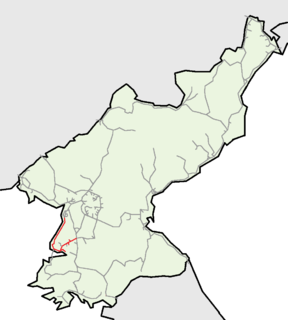Sinnamp'o 신남포 | ||||||||||||||||
|---|---|---|---|---|---|---|---|---|---|---|---|---|---|---|---|---|
| Korean name | ||||||||||||||||
| Hangul | 신남포역 | |||||||||||||||
| Hanja | 新 南 浦 驛 | |||||||||||||||
| Revised Romanization | Sinnampo-yeok | |||||||||||||||
| McCune–Reischauer | Sinnamp'o-yŏk | |||||||||||||||
| General information | ||||||||||||||||
| Location | Hanggu-guyŏk, Namp'o-tŭkpyŏlsi North Korea | |||||||||||||||
| Coordinates | 38°45′20″N125°23′48″E / 38.7555°N 125.3968°E Coordinates: 38°45′20″N125°23′48″E / 38.7555°N 125.3968°E | |||||||||||||||
| Owned by | Korean State Railway | |||||||||||||||
| Platforms | 1 | |||||||||||||||
| Tracks | 5 | |||||||||||||||
| History | ||||||||||||||||
| Opened | after 1953 | |||||||||||||||
| Electrified | yes | |||||||||||||||
| Services | ||||||||||||||||
| ||||||||||||||||
Sinnamp'o Station is a freight-only railway station in Hanggu-guyŏk, Namp'o Special City, North Korea, on the P'yŏngnam Line of the Korean State Railway; it is also the starting point of the Namp'ohang Line. [1]
Hanggu-guyŏk is a kuyŏk (District) in Namp'o Special City, South P'yŏngan province, North Korea.

Nampo, also spelled Namp'o, is a city and seaport in South Pyongan Province, North Korea, which lies on the northern shore of the Taedong River, 15 km east of the river's mouth. Formerly known as Chinnamp'o, it was a provincial-level "Directly Governed City" ("Chikhalsi") from 1980 to 2004, and was designated a "Special City", in 2010, and made a part of South P'yŏngan. Namp'o is approximately 50 km southwest of P'yŏngyang, at the mouth of the Taedong River.

North Korea, officially the Democratic People's Republic of Korea, is a country in East Asia constituting the northern part of the Korean Peninsula, with Pyongyang the capital and the largest city in the country. The name Korea is derived from Goguryeo which was one of the great powers in East Asia during its time, ruling most of the Korean Peninsula, Manchuria, parts of the Russian Far East and Inner Mongolia, under Gwanggaeto the Great. To the north and northwest, the country is bordered by China and by Russia along the Amnok and Tumen rivers; it is bordered to the south by South Korea, with the heavily fortified Korean Demilitarized Zone (DMZ) separating the two. Nevertheless, North Korea, like its southern counterpart, claims to be the legitimate government of the entire peninsula and adjacent islands. Both North Korea and South Korea became members of the United Nations in 1991.
The station was opened by the Korean State Railway after the end of the Korean War, at the same time as the Nampo'hang Line, to serve glass factories and shipbuilders located in the area. [2] This station also serves the Ch'ŏnji Lubricant Factory and the Pyonghwa Motors factory. [3]

The Korean War was a war between North Korea and South Korea. The war began on 25 June 1950 when North Korea invaded South Korea following a series of clashes along the border.
The Ch'ŏnji Lubricant Factory, located in Hanggu-guyŏk, Namp'o, North Korea, is a factory producing various lubricating oils and greases and transformer oils. On 5 August 2014 Kim Jong Un visited the factory, proclaiming the factory's products to be "as good as the imported ones". The factory is served by a railway connection to Sinnamp'o Station on the P'yŏngnam Line of the Korean State Railway.

